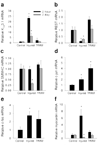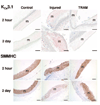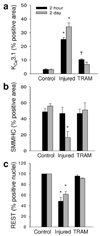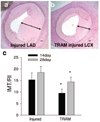Local delivery of the KCa3.1 blocker, TRAM-34, prevents acute angioplasty-induced coronary smooth muscle phenotypic modulation and limits stenosis
- PMID: 18309114
- PMCID: PMC2652246
- DOI: 10.1161/ATVBAHA.107.155796
Local delivery of the KCa3.1 blocker, TRAM-34, prevents acute angioplasty-induced coronary smooth muscle phenotypic modulation and limits stenosis
Abstract
Objective: We previously demonstrated that upregulation of intermediate-conductance Ca(2+)-activated K(+) channels (K(Ca)3.1) is necessary for mitogen-induced phenotypic modulation in isolated porcine coronary smooth muscle cells (SMCs). The objective of the present study was to determine the role of K(Ca)3.1 in the regulation of coronary SMC phenotypic modulation in vivo using a swine model of postangioplasty restenosis.
Methods and results: Balloon angioplasty was performed on coronary arteries of swine using either noncoated or balloons coated with the specific K(Ca)3.1 blocker TRAM-34. Expression of K(Ca)3.1, c-jun, c-fos, repressor element-1 silencing transcription factor (REST), smooth muscle myosin heavy chain (SMMHC), and myocardin was measured using qRT-PCR in isolated medial cells 2 hours and 2 days postangioplasty. K(Ca)3.1, c-jun, and c-fos mRNA levels were increased 2 hours postangioplasty, whereas REST expression decreased. SMMHC expression was unchanged at 2 hours, but decreased 2 days postangioplasty. Use of TRAM-34 coated balloons prevented K(Ca)3.1 upregulation and REST downregulation at 2 hours, SMMHC and myocardin downregulation at 2 days, and attenuated subsequent restenosis 14 and 28 days postangioplasty. Immunohistochemical analysis demonstrated corresponding changes at the protein level.
Conclusions: Blockade of K(Ca)3.1 by delivery of TRAM-34 via balloon catheter prevented smooth muscle phenotypic modulation and limited subsequent restenosis.
Figures






Comment in
-
Preventing stenosis by local inhibition of KCa3.1: a finger on the phenotypic switch.Arterioscler Thromb Vasc Biol. 2008 Jun;28(6):1036-8. doi: 10.1161/ATVBAHA.108.164988. Arterioscler Thromb Vasc Biol. 2008. PMID: 18495973 No abstract available.
Similar articles
-
Upregulation of intermediate-conductance Ca2+-activated K+ channel (IKCa1) mediates phenotypic modulation of coronary smooth muscle.Am J Physiol Heart Circ Physiol. 2006 Nov;291(5):H2493-503. doi: 10.1152/ajpheart.01254.2005. Epub 2006 Jun 23. Am J Physiol Heart Circ Physiol. 2006. PMID: 16798818
-
Preventing stenosis by local inhibition of KCa3.1: a finger on the phenotypic switch.Arterioscler Thromb Vasc Biol. 2008 Jun;28(6):1036-8. doi: 10.1161/ATVBAHA.108.164988. Arterioscler Thromb Vasc Biol. 2008. PMID: 18495973 No abstract available.
-
Up-regulation of KCa3.1 promotes human airway smooth muscle cell phenotypic modulation.Pharmacol Res. 2013 Nov;77:30-8. doi: 10.1016/j.phrs.2013.09.002. Epub 2013 Sep 18. Pharmacol Res. 2013. PMID: 24055799
-
Store-operated Ca(2+) entry is not essential for PDGF-BB induced phenotype modulation in rat aortic smooth muscle.Cell Calcium. 2010 Jul;48(1):10-8. doi: 10.1016/j.ceca.2010.06.001. Cell Calcium. 2010. PMID: 20619453 Free PMC article.
-
Inhibition of vascular calcification by block of intermediate conductance calcium-activated potassium channels with TRAM-34.Pharmacol Res. 2014 Jul;85:6-14. doi: 10.1016/j.phrs.2014.04.013. Epub 2014 May 6. Pharmacol Res. 2014. PMID: 24813858
Cited by
-
High expression of KCa3.1 in patients with clear cell renal carcinoma predicts high metastatic risk and poor survival.PLoS One. 2015 Apr 7;10(4):e0122992. doi: 10.1371/journal.pone.0122992. eCollection 2015. PLoS One. 2015. PMID: 25848765 Free PMC article.
-
KCa3.1 inhibition switches the phenotype of glioma-infiltrating microglia/macrophages.Cell Death Dis. 2016 Apr 7;7(4):e2174. doi: 10.1038/cddis.2016.73. Cell Death Dis. 2016. PMID: 27054329 Free PMC article.
-
KCa 3.1 channels maintain endothelium-dependent vasodilatation in isolated perfused kidneys of spontaneously hypertensive rats after chronic inhibition of NOS.Br J Pharmacol. 2012 Oct;167(4):854-67. doi: 10.1111/j.1476-5381.2012.02062.x. Br J Pharmacol. 2012. PMID: 22646737 Free PMC article.
-
Kv1.3 Channel Inhibition Limits Uremia-Induced Calcification in Mouse and Human Vascular Smooth Muscle.Function (Oxf). 2020 Dec 4;2(1):zqaa036. doi: 10.1093/function/zqaa036. eCollection 2021. Function (Oxf). 2020. PMID: 35330975 Free PMC article.
-
The smooth muscle cell-restricted KCNMB1 ion channel subunit is a direct transcriptional target of serum response factor and myocardin.J Biol Chem. 2009 Nov 27;284(48):33671-82. doi: 10.1074/jbc.M109.050419. Epub 2009 Oct 1. J Biol Chem. 2009. PMID: 19801679 Free PMC article.
References
-
- Owens GK, Kumar MS, Wamhoff BR. Molecular regulation of vascular smooth muscle cell differentiation in development and disease. Physiol Rev. 2004;84:767–801. - PubMed
-
- Layne MD, Yet SF, Maemura K, Hsieh CM, Liu X, Ith B, Lee ME, Perrella MA. Characterization of the mouse aortic carboxypeptidase-like protein promoter reveals activity in differentiated and dedifferentiated vascular smooth muscle cells. Circ Res. 2002;90:728–736. - PubMed
-
- Bar H, Wende P, Watson L, Denger S, van Eys G, Kreuzer J, Jahn L. Smoothelin is an indicator of reversible phenotype modulation of smooth muscle cells in balloon-injured rat carotid arteries. Basic Res Cardiol. 2002;97:9–16. - PubMed
-
- Nagai R, Suzuki T, Aizawa K, Miyamoto S, Amaki T, Kawai-Kowase K, Sekiguchi KI, Kurabayashi M. Phenotypic modulation of vascular smooth muscle cells: dissection of transcriptional regulatory mechanisms. Ann N Y Acad Sci. 2001;947:56–67. - PubMed
Publication types
MeSH terms
Substances
Grants and funding
LinkOut - more resources
Full Text Sources
Other Literature Sources
Molecular Biology Databases
Miscellaneous

